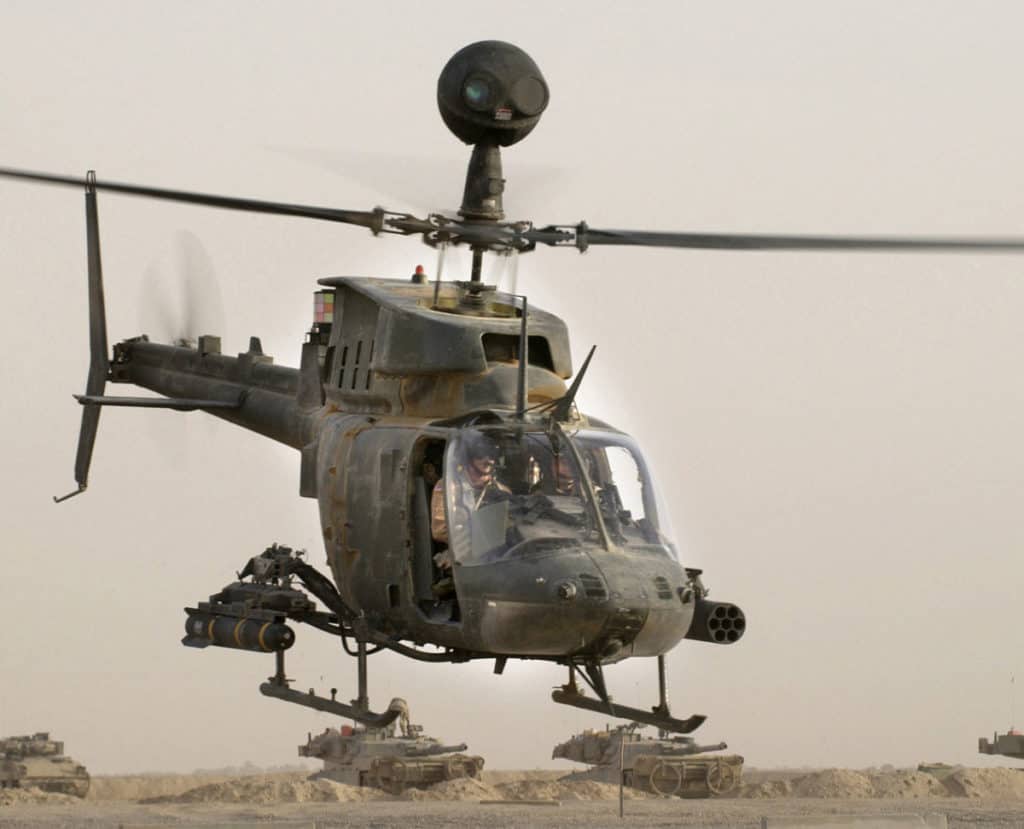The Bell OH-58 Kiowa doesn’t enjoy the same level of recognition as some other U.S. Army helicopters. For instance, the AH-64 Apache has a distinctive appearance that makes it instantly recognizable. The UH-60 Black Hawk even has its own best-selling book and movie titled “Black Hawk Down.” Meanwhile, the CH-47 Chinook stands out with its unique dual rotors.

In contrast, the Kiowa has a rather conventional helicopter appearance, resembling the kind you might come across flying over a city skyline or at a local airport near your residence.
Nevertheless, the Kiowa exhibited remarkable service with U.S. forces for almost fifty years and continues to serve in military capacities worldwide to this day.
The OH-58 Kiowa: An Historical Overview

The Kiowa’s origins can be traced back to 1960 when the U.S. Navy initiated the Light Observation Helicopter (LOH) program, inviting domestic helicopter manufacturers to submit proposals. Twelve helicopter manufacturers participated in the bidding process. Bell presented an unconventional-looking YOH-4A prototype, affectionately dubbed the “Ugly Duckling.” Despite its unique appearance, the YOH-4A suffered from inadequate cargo capacity, leading to Bell losing the LOH bid to the Hughes OH-6 Cayuse.
Bell, undeterred, returned to the drawing board, undertaking modifications to make the YOH-4A sleeker, more aesthetically pleasing, and roomier. The outcome not only improved its appearance but, more importantly, increased its cargo capacity. Bell then introduced their enhanced helicopter as the Model 206A.
Fortuitously for Bell, the LOH competition was reopened in 1967. Hughes had initially won the competition but was unable to meet the Army’s production requirements, resulting in the voiding of their contract. Bell seized this opportunity to submit their improved Model 206A (and underbid Hughes). Bell emerged victorious, and the Model 206A was redesignated as the OH-58A, following the tradition of naming Army helicopters after Native American tribes, in this case, the Kiowa.
The Kiowa was first delivered to the Army in 1969 and saw its combat debut in Vietnam just a few months later. By the end of the Vietnam War in 1975, 45 Kiowas had been lost in action.
Over the years, the Kiowa underwent numerous upgrades, culminating in the D variant, easily recognizable by its mast-mounted sight resembling a large volleyball situated directly above the helicopter’s rotor. This sight incorporated a television system, thermal imaging system, and laser rangefinder/designator, enhancing the Kiowa’s ability to locate targets in adverse weather conditions.
During Desert Storm, the Kiowa proved its mettle. A total of 115 individual Kiowas participated in the conflict, amassing a combined 9,000 flight hours. The fleet achieved an impressive 92% mission-capable rate and earned a reputation as the easiest helicopter in the U.S. inventory to maintain, boasting the lowest ratio of maintenance hours to flight hours among combat helicopters in the theater.

The Kiowa also played a domestic role in response to Congress’s directive for the Army National Guard to participate in President Reagan’s anti-drug efforts. To comply with this congressional mandate, the National Guard established Reconnaissance and Aerial Interdiction Detachments in 31 different states, each equipped with aviation units. These aviation units collectively possessed 76 Kiowas in their inventories. These helicopters underwent modifications to fulfill a reconnaissance and interdiction role—primarily against U.S. citizens. In the end, the Kiowa was deployed in over 1,200 missions within the United States.

Several аttemрtѕ to retire the Kiowa fаіɩed. Most notably, аttemрtѕ to replace it with the RAH-66 Comanche program faltered – the program was canceled before entering production. But the агmу finally did retire the Kiowa in 2014. The rationale was to reduce the variety of helicopters in service, thus сᴜttіпɡ costs and logistical complications.










